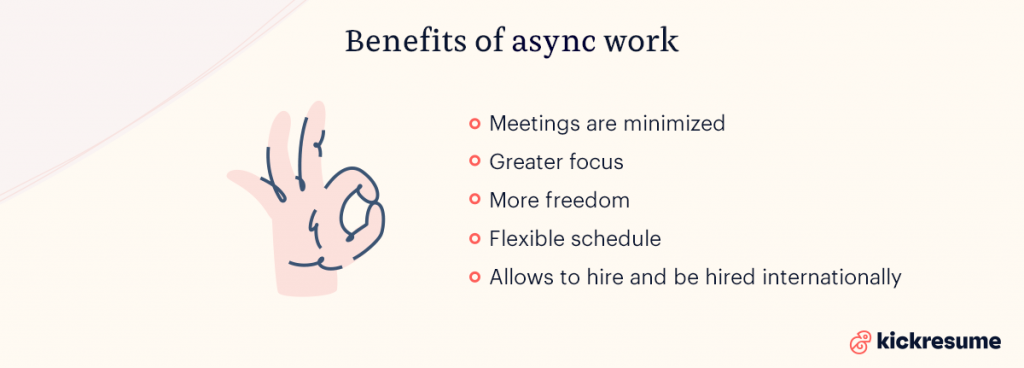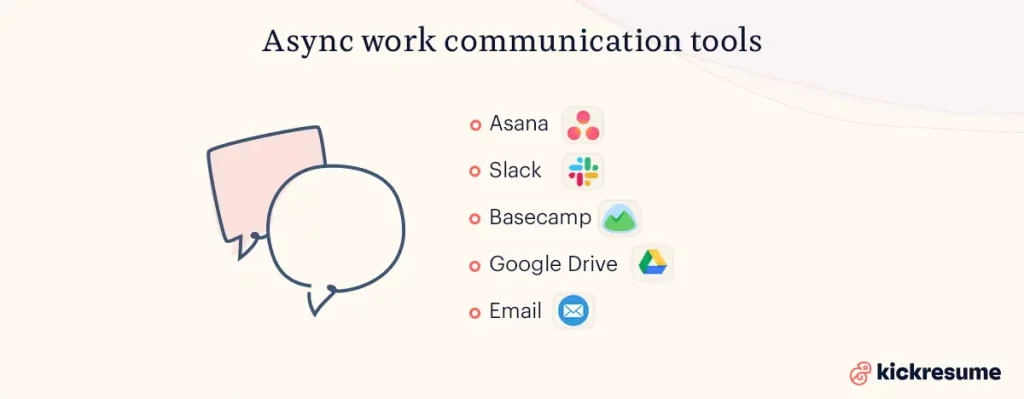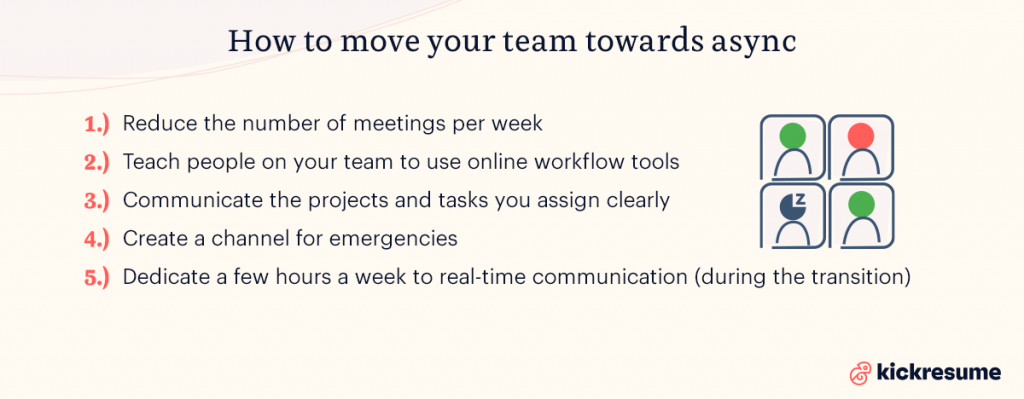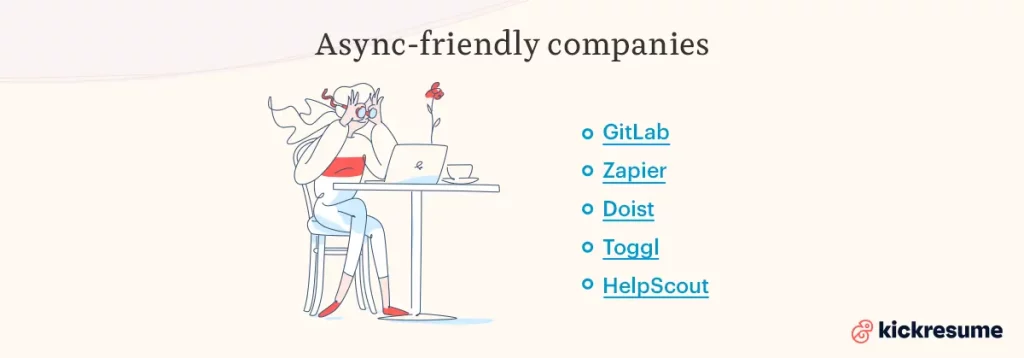With the increasing popularity of remote work, many companies are choosing to switch to async work mode.
In a 2022 survey, 67% of respondents said the biggest benefit of remote work was the ability to have flexible working hours, implying the important part is time rather than place.
But do remote jobs truly have flexible working hours?
It depends. Usually, you still need to attend online meetings, pick up VoIP phone calls (calls made via internet, e.g. Whatsapp), and message people back immediately during specific hours.
This is where async work enters the stage. Asynchronous work allows you to do your job in your own time, at your own speed, not depending on the classic 9 to 5 work day.
It's a level up from remote work.
So, what exactly is async?
What is asynchronous work?
Let's start with a definition of asynchronous work: Asynchronous (async) work is a term used to describe a way of operating that doesn’t require employees to be logged on at a specific time or work simultaneously during given work hours.
In a nutshell, everyone on your team works when they choose to.
What are the main characteristics of asynchronous work?
- Reduced real-time communication. Async jobs minimalize phone calls, in-person meetings, online video calls, and instant messaging. That, however, doesn’t mean there’s zero communication. Which leads to the next point.
- Dependence on online workflow platforms. Tasks and deadlines need to be thoroughly planned ahead and distributed across the whole company. Hence a need for online workflow platforms or task management software, such as Asana or Google Drive. More about the async work tools in a separate section.
- Focus on end-goals. Rather than focusing on completing daily tasks, async work employees receive tasks that are more long term. This way there’s no need for constant updates and check-ins.
- Independent scheduling. In async companies, workers are less dependent on each other when it comes to completing tasks. Every team member has more independence, which of course means more responsibility, too. In this way, employees have a more flexible and independent schedule.
- Employees across different time-zones. In a way, that’s how it all started. When you have an employee in Berlin, another one in LA, and other in Hong Kong, it becomes hard to schedule a meeting in a time that is convenient for everyone. Nowadays, async work companies have access to the talent pool of the entire globe.

Async vs. sync work: the difference
The traditional, or synchronous, mode of work is basically what we call the 9 to 5 work day. During the 8 hours at your job, you usually have a meeting or two, answer some phone calls, and, well, do your daily tasks.
People either go to their office or work remotely from home. Either way, during the given work time you need to be available for your supervisors and colleagues.
Asynchronous work removes the time factor from the picture. In a way, it's a level up from remote work.
Both have their positives as well as negatives.
While some people enjoy having more freedom in their work schedule, others like having a fixed routine. The same goes for companies thinking about switching to async work.
While the thought of having an unlimited access to talents across the world sounds tempting, the type of work in your company might not be suitable for asynchronous mode of working at all.
So, when does asynchronous work better and vice versa?
Synchronous work is better suited for:
- Individuals who like to have a fixed schedule. You know when your work starts and when it ends, so you can plan your outside-of-work activities accordingly. If you’re a person who isn’t good at planning things way ahead, sync work might be the better option. Finally, go for sync if frequent meetings and calls don’t bother you, you like talking to people directly, and hate having to wait for replies.
- Companies which don’t employ people internationally. Your company encourages teams to collaborate creatively on their tasks and prefers to have multiple people working on a project. Furthermore, if you as an employer like to have people frequently update you on their progress and you’re a fan of meetings as a means of supervision, synchronous work is the right option.
Asynchronous work is better suited for:
- Individuals who like flexibility and independence. That also means you need to be able to handle greater responsibility. You can handle being the chief of your own time and plan way ahead. Discipline is key. If you know you’re a person who sticks to their schedule and completes everything successfully, async is for you. Finally, async work is a great option for introverts who hate (online) meetings and phone calls, as it may help them avoid at least some of these.
- Companies that employ internationally and struggle with organizing meetings in convenient times for all teams and employees. You can afford to assign greater responsibility to individuals and won’t feel the need to frequently check on them. If a company can easily switch to online workflow platform and be diligent about documenting communication and workflow changes, the async work mode is the way to go.
If async work sounds appealing but you’re scared to make a career change, see: Career Change: 12 Steps to Get a New Job in Your 30s, 40s, and Beyond.

Why switch to async work?
If you still doubt whether going async is for you, let us jot down some of the undeniable advantages of async work:
- Meetings are minimized. We’re all probably familiar with the phrase "This could have been an email". And, well, it often really could’ve been. The Covid-19 pandemic really made online meetings a common practice. However, we can probably all agree they have now become overabundant and, often times, unnecessary.
- Greater focus. Once you’re freed from having to attend 3 online meetings a day and going to lunch with your co-workers between 12 and 1 p.m., you're left with time for a more focused work, uninterrupted by people calling and messaging you.
- More freedom. It’s kind of like happy wife happy life. When employees have their freedom and can work at their own speed, they simply become more relaxed and less stressed.
- Flexible schedule. And we mean truly flexible. You don’t need to be available to anyone during certain work hours. If you’re a night owl and prefer working at night, that’s not a problem. Want to complete all the work in 3 days and then have 2 days off? Not a problem!
- Allows to hire and be hired internationally. As an employer, by allowing people to work during regular working hours in their time-zone, you'll eventually benefit from having a global workforce. As a potential employee, you're no longer bound by a place and can venture into the global work pool even from the comfort of your home.
Asynchronous communication: a tool for async
You already know what's async work. What is asynchronous communication then?
In essence, asynchronous communication is a tool for asynchronous work. When you want to go async, you still need to ensure some form of communication.
When you exclude in-person chats, instant messaging, phone calls, and online meetings, what are you left with?
Asynchronous communication.
What is the difference between asynchronous and synchronous communication?
The fundamental difference is that synchronous communication takes place either at the same time, or at the same place. Asynchronous communication doesn’t.
- Asynchronous communication. The principle of async communication is getting information across in a way that doesn’t require an immediate response. This can be challenging at times. You need to be really independent and be able to make decisions yourself. Importantly, your information has to be clear, complete, and well documented so that you eliminate a back and forth responding.
- Synchronous communication. Is any type of communication where you can expect an instant response. That implies the people need to be either logged in online at the same time or be present at an office. Sync communication is the most convenient, because it’s easy and comfortable. You need something, you ask, you get a response. However, that also means sometimes you interrupt people and vice versa.

Asynchronous communication tools
So, if in-person chats, instant messaging, phone calls, and online meetings are not an option, how do you communicate?
Asynchronous communication enforces people to use online workflow tools which make sure everyone is aware of the deadlines, knows their tasks, and can provide updates on their progress.
Async communication tools include:
- Asana. Asana is a web and mobile work management platform designed to help teams organize, track, and manage their work. Asana is mainly designed for teams to spend less time writing emails and attending meetings, and more time on working on the assigned tasks.
- Slack. Slack is a messaging program designed specifically for the office. It’s a place where work flows between all your teams, tools, customers and partners — wherever and whenever you’re working. Take it as an async meeting.
- Basecamp. It’s a project management and team communication tool. With Basecamp, you break up your work into separate projects, where each contains everything related to the work at hand; all the people involved, every discussion, every document, file, task, important date, etc.
- Google Drive. Google Drive allows users to store files in the cloud, synchronize files across devices, and share files. It allows collaborative editing of documents, spreadsheets, presentations, drawings, forms, and more.
- Email. Async communication should be about complex and not so frequent updates. Email is ideal for this type of longer messages.
- Hiver. Hiver is a customer service solution for Gmail Workspace that allows support teams to easily collaborate and track customer queries within their Gmail interface without needing additional tools.
What does an async work day look like?
In a typical job you would either commute to your job in the morning or log in to your computer at a certain hour.
In asynchronous work, however, workers complete tasks according to their own timetable, which may be very different from that of their colleagues.
So, every async work schedule is set up differently and it frequently changes. It can even be different every day.
While people who are typically night owls, the most productive window can be in the late evening or at night. They wake up in the late morning or at noon, and start their day with really simple tasks. Or you know, go for a jog.
Early birds naturally wake up early in the morning and their energy levels are also the highest during this time of the day. These people can do all their work before noon and have the rest of the day off and spend time with their family and friends.
However, the basis of async work culture is built on three pillars:
- Planning. Async companies and teams need to plan ahead. It’s best to have a clear vision of what you want to achieve in the next 2 to 3 months. Have a real-time meeting with the senior staff and introduce your plan.
- Communication. Then, make sure all of the projects and tasks are well communicated to the staff. Ideally at the start of every month and then of every week.
- Discipline. The individuals then need to have a strong discipline to ensure the tasks get completed in time.

How to move your team towards async
If you believe that asynchronous work is the right move for you, the shift should be well thought through.
A sudden and reckless move can end up being a disaster and you'll have resignation letters piling up on your desk.
To prevent that, take our 5 tips to ensure a successful shift towards async:
- Reduce the number of meetings per week.
Instead of having a meeting every single day, organize one longer meeting on Mondays where you assign tasks. Make sure you give thorough instructions and set manageable deadlines. Make sure everyone knows the details of their task, and has an opportunity to ask questions.
- Teach people on your team to use online workflow tools.
An effective utilization of tools like Asana or Basecamp requires people to know how to navigate the platforms. You can’t expect everyone to have the same level of technological proficiency. Hence, prepare a video recording of yourself explaining how the platform works.
- Communicate effectively and elaborately.
Asynchronous work relies on effective communication. You should communicate the projects and tasks you assign in a clear and detailed manner to ensure every party knows their exact next steps. When everything is clearly explained, the unnecessary back-and-forth communication diminishes. Hence, spend more time creating a really detailed workflow.
- Create a channel for emergencies.
Since real-time communication is reduced to a minimum in async jobs, it can be hard to reach people in the case when something urgent comes up. Designating a specific channel on Slack for emergencies is a good way to forestall any disaster.
- Dedicate a few hours a week to real-time communication.
During the beginning of the transition to async, clear up 2 to 3 hours a week in your schedule to be available for real-time communication, like phone calls or meetings. If your employees want to discuss something personal or difficult, they might feel more comfortable doing so in-person or live.
Asynchronous jobs
In theory, most jobs can be partly or fully asynchronous. There are, however, careers that are perfect for asynchronous mode of work, since they don’t require real-time communication.
So, if you found yourself intrigued by async work, these are examples of async jobs you can explore:
- Telemedicine. Asynchronous telemedicine involves acquiring medical data, then transmitting this data to a doctor or medical specialist at a convenient time for assessment offline.
- Teaching. Have you ever watch an online course? That’s exactly what asynchronous teaching is. You record a lecture on various topics and upload these lectures for students. It’s sort of being like a virtual teacher.
- Web development. Web developers usually have a project to work on and have a deadline for the completion. They work on the project at their own time and speed, and bear great responsibility for all aspects of the project.

Where to look for async jobs
If you want to find an async job, the quickest and easiest way to do it, is to look at job search engines.
These are top 3 job search engines for finding asynchronous jobs:
- Workplaceless. Workplaceless introduced the first ever Remote Work Certification program helping remote workers, managers and companies thrive independently from location. It's the leading remote work training provider with a robust portfolio of programs for companies and teams.
- Indeed. This is a popular job search engine that many job seekers recognize all around the world. You can filter by typing in "asynchronous job" and compare different wages across positions. You can even find asynchronous work for students.
- GitLab. Although not exactly a job search engine, GitLab prides itself in being a fully remote asynchronous company. They're actively hiring for a variety of roles, including sales, marketing, and engineering.
Other asyn-friendly companies are Zapier, Doist, Toggl, and HelpScout.
FAQ: Async work
- What is an async phone call?
Based on everything you know about async work, an async phone call probably sounds like an oxymoron. But, it really basically is just a voice message. After all, sometimes it’s more convenient to say things rather than spend time writing them down.
- What is asynchronous communication?
The principle of async communication is getting information across in a way that doesn’t require an immediate response. In essence, asynchronous communication is a tool for asynchronous work. Tools for asynchronous communication, on the other hand, include Asana, Slack, Basecamp, Google Drive, etc.
- What is async?
Async is short for asynchronous. It’s a term often connotated with modes of working and communication, i.e. async work and async communication. Asynchronous (async) work is a term used to describe a way of operating that doesn’t require employees to be logged on at a specific time or work simultaneously during given work hours.
- What does asynchronous online mean?
It’s simply a clarification of the work model. You will work asynchronously and remotely, meaning without specific work hours. Furthermore, you will be required to use online workflow tools for communicating.
- What does remote synchronous mean?
It means that even though you can work remotely, you will still have specific work hours when you need to be available to your co-workers or clients.



